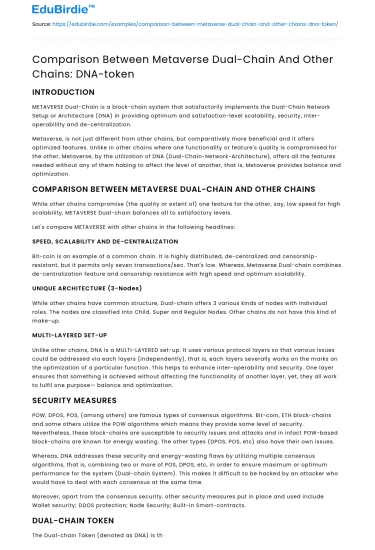INTRODUCTION
METAVERSE Dual-Chain is a block-chain system that satisfactorily implements the Dual-Chain Network Setup or Architecture (DNA) in providing optimum and satisfaction-level scalability, security, inter-operabililty and de-centralization.
Metaverse, is not just different from other chains, but comparatively more beneficial and it offers optimized features. Unlike in other chains where one functionality or feature's quality is compromised for the other, Metaverse, by the utilization of DNA (Dual-Chain-Network-Architecture), offers all the features needed without any of them habing to affect the level of another, that is, Metaverse provides balance and optimization.
Save your time!
We can take care of your essay
- Proper editing and formatting
- Free revision, title page, and bibliography
- Flexible prices and money-back guarantee
COMPARISON BETWEEN METAVERSE DUAL-CHAIN AND OTHER CHAINS
While other chains compromise (the quality or extent of) one feature for the other, say, low speed for high scalability, METAVERSE Dual-chain balances all to satisfactory levels.
Let's compare METAVERSE with other chains in the following headlines:
SPEED, SCALABILITY AND DE-CENTRALIZATION
Bit-coin is an example of a common chain. It is highly distributed, de-centralized and censorship-resistant, but it permits only seven transactions/sec. That's low. Whereas, Metaverse Dual-chain combines de-centralization feature and censorship resistance with high speed and optimum scalability.
UNIQUE ARCHITECTURE (3-Nodes)
While other chains have common structure, Dual-chain offers 3 various kinds of nodes with individual roles. The nodes are classified into Child, Super and Regular Nodes. Other chains do not have this kind of make-up.
MULTI-LAYERED SET-UP
Unlike other chains, DNA is a MULTI-LAYERED set-up. It uses various protocol layers so that various issues could be addressed via each layers (independently), that is, each layers severally works on the marks on the optimization of a particular function. This helps to enhance inter-operability and security. One layer ensures that something is achieved without affecting the functionality of another layer, yet, they all work to fulfil one purpose— balance and optimization.
SECURITY MEASURES
POW, DPOS, POS, (among others) are famous types of consensus algorithms. Bit-coin, ETH block-chains and some others utilize the POW algorithms which means they provide some level of security. Nevertheless, these block-chains are susceptible to security issues and attacks and in infact POW-based block-chains are known for energy wasting. The other types (DPOS, POS, etc) also have their own issues.
Whereas, DNA addresses these security and energy-wasting flaws by utilizing multiple consensus algorithms, that is, combining two or more of POS, DPOS, etc, in order to ensure maximum or optimum performance for the system (Dual-chain System). This makes it difficult to be hacked by an attacker who would have to deal with each consensus at the same time.
Moreover, apart from the consensus security, other security measures put in place and used include Wallet security; DDOS protection; Node Security; Built-in Smart-contracts.
DUAL-CHAIN TOKEN
The Dual-chain Token (denoted as DNA) is the utility-token of the Metaverse Dual-chain (block-chain). It sis the basic tool for the operations of thr chain's ecosystem.
FUNCTIONS
- Exchange: It's functions as the system's exchange-medium.
- Voting tool: It is the basic measuring tool used in nodes voting.
- Assets base/collateral: functions as the asset security/base for Smart-contracts.
- Payments: transactions payments areade in DNA-token.
- Staking: DNA tokens amount is considered alongside staking time-length I'm determining staking proceeds.
CONCLUSION
We have been able to describe what Metaverse is about and have also been able to compare it with other chains. It is evident that Metaverse Dual-chain which is based on the DNA (structure) is much more advantageous than other chains I'm aspects of speed of transactions, security, scalability, inter-operability, coat, de-centralization, etc. The Dual-chain Token (DNA or DNA-token) serves as the utility-token of the system.






 Stuck on your essay?
Stuck on your essay?

